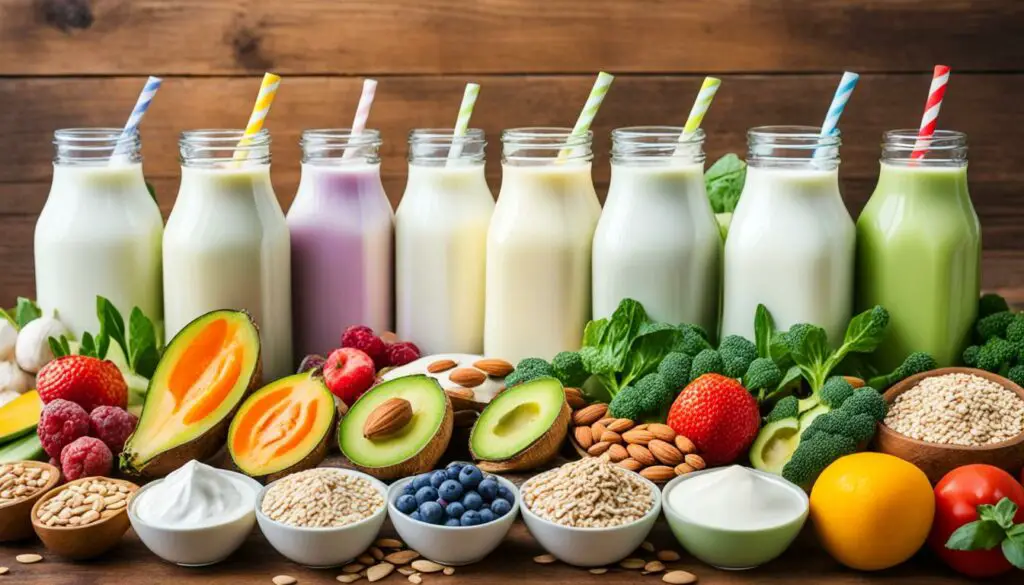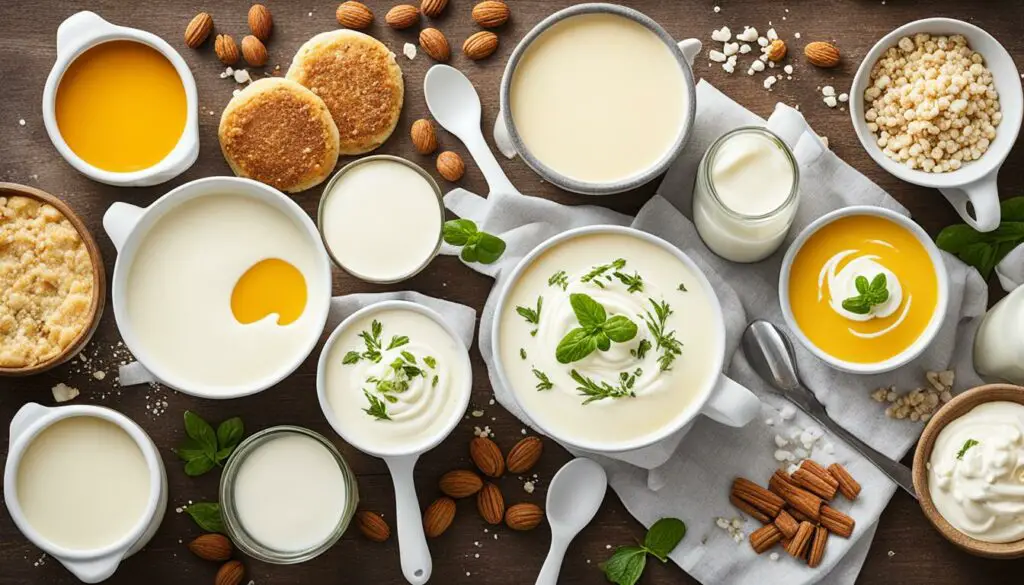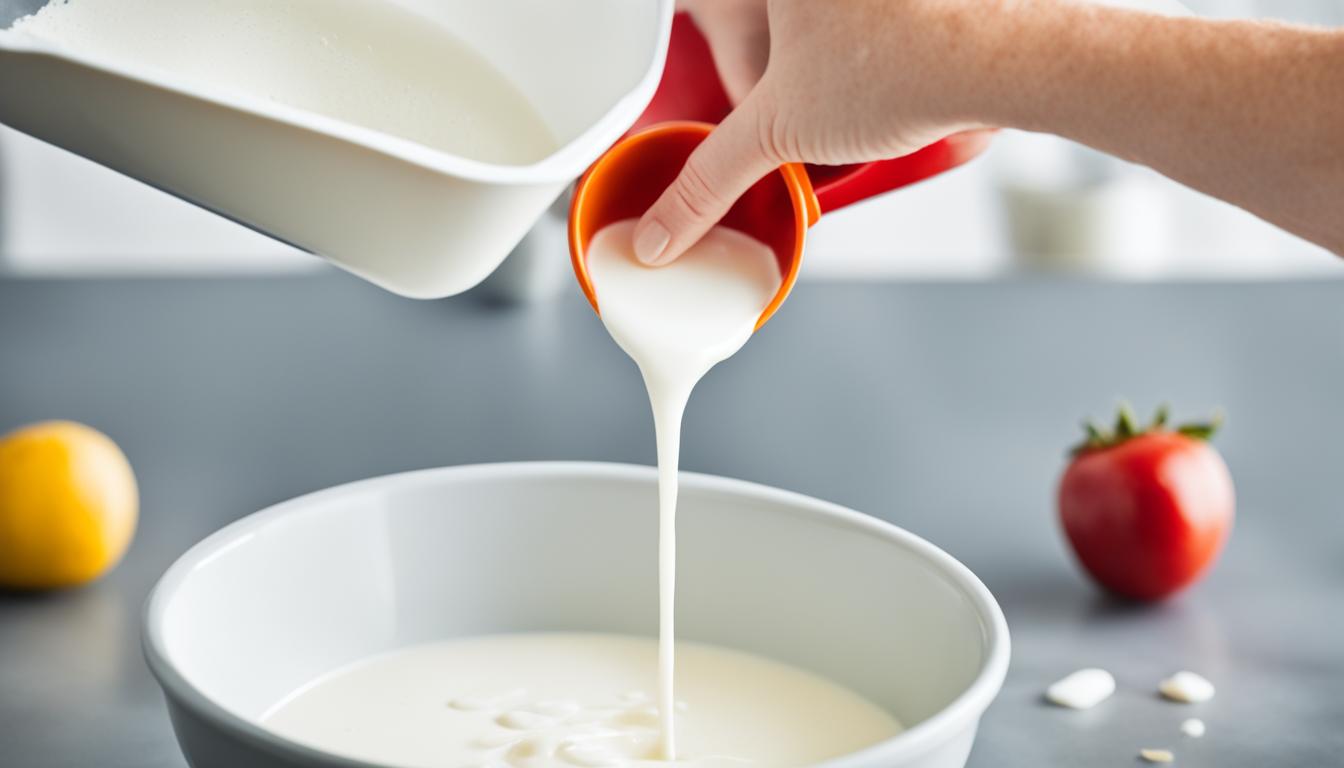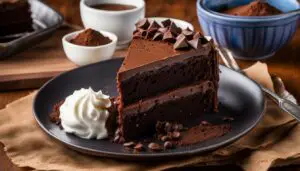Did you know that whole milk is included in over 75% of recipes? Whether it’s a creamy pasta sauce or a moist chocolate cake, whole milk plays a crucial role in enhancing flavors and textures in cooking and baking. But what if you don’t have whole milk on hand or prefer a non-dairy option? Can you substitute it with something else? Let’s explore the world of whole milk substitutes and find the best alternatives for your favorite recipes.
Contents
- 1 Dairy-based Whole Milk Substitutes
- 2 Non-Dairy Whole Milk Substitutes
- 3 Tips for Substituting Whole Milk in Baking
- 4 Recipes Where Whole Milk Substitutes Can be Used
- 5 Benefits of Using Whole Milk in Cooking
- 6 Considerations When Substituting Whole Milk
- 7 Experimenting with Whole Milk Substitutes
- 8 Conclusion
- 9 FAQ
- 9.1 Can I substitute whole milk in recipes?
- 9.2 What are some dairy-based substitutes for whole milk?
- 9.3 What are some non-dairy substitutes for whole milk?
- 9.4 Can I use these substitutes in baking?
- 9.5 In which recipes can whole milk substitutes be used?
- 9.6 What are the benefits of using whole milk in cooking?
- 9.7 What should I consider when substituting whole milk?
- 9.8 How can I experiment with whole milk substitutes?
- 9.9 Do I have to use whole milk in every recipe?
- 10 Source Links
Key Takeaways:
- Whole milk is a common ingredient in recipes, but it’s not always essential.
- There are various dairy-based and non-dairy substitutes that can be used instead of whole milk.
- The choice of substitute depends on personal preferences, dietary needs, and the specific requirements of the recipe.
- Experimentation and adjustments may be necessary to find the best substitute for each individual recipe.
- Whether using a dairy-based substitute like 2% milk or a non-dairy option like oat milk, it’s important to consider the impact on texture, flavor, and overall outcome.
Dairy-based Whole Milk Substitutes
If you prefer to use dairy-based substitutes, there are a few options to consider. These dairy options for recipes can be convenient alternatives when whole milk is not available. Here are some of the best milk for cooking substitutes:
1. 2% Milk
2% milk is an excellent substitute for whole milk in recipes. The milkfat content difference is minimal, making it a suitable 1:1 replacement. It maintains the creamy texture and richness that whole milk provides, ensuring your dishes turn out beautifully.
2. Half and Half
Half and half, with its milkfat content ranging from 10% to 18%, can be diluted with water to replace whole milk. This method works well for recipes that require whole milk. Simply mix half and half with an equal amount of water to create a substitute that closely resembles the consistency and flavor of whole milk.
3. Heavy Cream
Heavy cream offers a higher milkfat content, making it an indulgent choice for substituting whole milk. Similar to half and half, you can dilute heavy cream with water in a 1:1 ratio to replace whole milk in recipes. The result is a rich and creamy substitute that adds depth of flavor to your dishes.
4. Yogurt and Sour Cream
Yogurt and sour cream can also be used as dairy options for recipes that call for whole milk. Simply thin them with water until they resemble the consistency of milk. This substitution works well in specific recipes, particularly ones that benefit from the tangy flavor and creamy texture that yogurt or sour cream provides.
Tip: When using yogurt or sour cream as a substitute, it’s best to choose plain varieties without added flavors or sweeteners.
Experiment with these dairy-based whole milk substitutes in your cooking and baking to find the option that works best for your needs. Remember to consider the recipe requirements and the desired outcome when making substitutions.
Summary
Dairy-based substitutes offer a range of options for replacing whole milk in recipes. 2% milk, half and half, heavy cream, yogurt, and sour cream can all be used with water to create substitutes that mimic the texture and flavor of whole milk. Whether you’re looking for a lower-fat alternative or a richer substitute, these dairy options provide versatility in your cooking and baking endeavors.
Non-Dairy Whole Milk Substitutes

If you’re looking for dairy-free alternatives, there are several options available. Oat milk, almond milk, soy milk, and coconut milk can all be used as substitutes for whole milk in recipes.
Oat milk has a creamy texture and neutral flavor, making it suitable for baking. It’s also a low-fat alternative for recipes, which can be beneficial for those following a low-fat diet.
Almond milk, although less creamy than dairy milk, can still provide good results in baked goods. It adds a subtle nutty flavor to recipes and is a popular choice for those with dairy allergies or lactose intolerance.
Soy milk, with its creamy body and high protein content, is another great option for substituting whole milk. It can add richness and moisture to recipes, and it’s an excellent choice for both sweet and savory dishes.
Coconut milk, with its higher fat content, can closely resemble whole milk in recipes. However, it’s important to note that coconut milk has a dairy flavor distinct coconut flavor that may not be suitable for all dishes. It works well in recipes that can complement its unique taste, such as curries, smoothies, and desserts.
When using non-dairy alternatives, it’s important to consider their dairy options for recipes. Some may have a thinner consistency than whole milk, so you may need to adjust the quantities accordingly. Additionally, keep in mind that non-dairy milk alternatives can vary in taste, so it’s essential to select one that complements the flavors of your recipe.
| Milk Alternative | Consistency | Taste | Usage |
|---|---|---|---|
| Oat milk | Creamy | Neutral | Baking, cooking, beverages |
| Almond milk | Less creamy | Subtle nutty flavor | Baking, cooking, beverages |
| Soy milk | Creamy | Mild soy flavor | Baking, cooking, beverages |
| Coconut milk | Creamy | Distinct coconut flavor | Cooking, curries, smoothies, desserts |
Note: The table above provides a comparison of various non-dairy milk alternatives as substitutes for whole milk.
Tips for Substituting Whole Milk in Baking
When it comes to substituting whole milk in baking recipes, it’s important to understand that baking is a science. Any changes made to the ingredients can significantly impact the texture and outcome of the final product. Therefore, it’s crucial to be precise and mindful of the substitutes used.
For those who prefer to stick with dairy-based options, there are a few reliable substitutes available. 2% milk, with its lower milkfat content, can generally be used as a 1:1 replacement for whole milk. Similarly, half and half can be diluted with water to create a suitable substitute. If you have heavy cream on hand, you can also mix it with water in a 1:1 ratio. These dairy-based substitutes can help maintain the desired texture and flavor in your baked goods.
Non-dairy substitutes are a popular choice, especially for those with dietary restrictions or preferences. When using non-dairy substitutes like almond milk, oat milk, soy milk, or coconut milk, it’s important to adjust the consistency. Thin these substitutes with water until they resemble the thickness and texture of whole milk. This will ensure that the desired structure of your baked goods is maintained throughout the cooking process.
Baking is all about precision and achieving the desired results. By carefully selecting and adjusting whole milk substitutes, you can still enjoy delicious and satisfying baked treats without compromising on taste or texture.
| Dairy-based Substitutes | Non-Dairy Substitutes |
|---|---|
| 2% milk | Almond milk |
| Half and half (diluted with water) | Oat milk |
| Heavy cream (diluted with water) | Soy milk |
| Coconut milk |
Experimentation may be necessary to find the best substitute for your specific recipe, taking into consideration personal preferences and dietary needs. By following these tips and exploring different options, you can confidently make substitutions and create delectable baked goods that cater to your unique requirements.
Recipes Where Whole Milk Substitutes Can be Used
Whole milk substitutes can be utilized in a wide range of recipes, both sweet and savory. Whether you’re baking cakes, cookies, bread, muffins, or cooking up delicious casseroles and sauces, there are plenty of options to replace whole milk. By selecting a substitute that complements the flavors and textures of your specific recipe, you can achieve excellent results without compromising on taste or quality.
When making cakes and cookies, a substitute for whole milk can maintain the moisture and tenderness of the final product. This is particularly important in recipes that rely on the richness and creaminess that whole milk provides. By choosing an appropriate substitute, such as oat milk or almond milk, you can still achieve a delightful texture and flavor.
In bread and muffin recipes, whole milk substitutes can contribute to the softness and moisture retention of the baked goods. Consider using soy milk or coconut milk as alternatives for whole milk. Their creamy and somewhat thicker consistency can result in similar desirable qualities in your bread and muffins.
For savory dishes like casseroles and sauces, whole milk substitutes can add richness and creaminess. Non-dairy options like oat milk and coconut milk work well in these recipes, as they can help create a luscious texture and enhance the flavors of your dishes.
Experimenting with different whole milk substitutes in your favorite recipes can open up a world of culinary possibilities. Don’t be afraid to get creative and try out various options to find the perfect substitute that suits your taste preferences and dietary needs.
Remember, the key to successfully using whole milk substitutes lies in understanding how different ingredients can contribute to the overall outcome of your recipe. By making thoughtful choices and finding the right substitute, you can enjoy delicious and satisfying dishes without compromising on taste or quality.
Benefits of Using Whole Milk in Cooking

When it comes to cooking, whole milk offers numerous benefits that enhance the taste, texture, and overall quality of your dishes. Whether you’re preparing a savory sauce or baking a sweet treat, using whole milk can elevate your culinary creations to another level.
“Whole milk adds richness and a creamy texture to dishes, enhancing their flavors and making them more indulgent.” – [Chef Name], Award-winning Pastry Chef
One of the primary benefits of using whole milk is its ability to provide richness and creaminess to your recipes. The higher fat content in whole milk contributes to a luscious texture, making dishes more satisfying and decadent. This is particularly important in recipes where a velvety mouthfeel is desired, such as custards, puddings, and creamy sauces.
Besides its luxurious texture, whole milk also plays a vital role in enhancing the flavor profiles of your dishes. It acts as a carrier, effectively bringing out the aromas and tastes of other ingredients. Whether you’re making a savory casserole or a delicate dessert, whole milk helps to balance the flavors and create a harmonious taste experience.
In baking, whole milk contributes to browning and moisture retention, resulting in perfectly golden and moist treats. The proteins and fat in whole milk promote a desirable level of browning on the surface of baked goods, giving them a visually appealing appearance. Additionally, the high moisture content in whole milk keeps baked goods tender and prevents them from drying out.
If you’re looking to create recipes that are rich, flavorful, and have a moist and appealing texture, whole milk is an excellent choice. Its unique properties make it a versatile ingredient that adds depth and complexity to a wide range of dishes.
| Benefits of Using Whole Milk in Cooking |
|---|
| Enhances richness and creaminess in recipes |
| Brings out the flavors of other ingredients |
| Promotes browning and moisture retention in baking |
| Creates tender and moist baked goods |
With its numerous benefits and culinary advantages, whole milk is a valuable ingredient that can elevate your cooking to new heights. So the next time you’re in the kitchen, don’t hesitate to reach for a carton of whole milk and create delectable dishes that will impress your family and friends.
Considerations When Substituting Whole Milk
When substituting whole milk in your recipes, it’s important to carefully consider the specific characteristics of the dish and the desired outcome. The fat content, texture, and flavor of the substitute can have a significant impact on the overall result. Whether you’re looking for the best milk for cooking or exploring dairy options for recipes, here are a few key considerations to keep in mind:
1. Dairy-Based Substitutes
If you’re looking for a substitute that closely resembles the texture and flavor of whole milk, dairy-based alternatives are a great option. Strong dairy options for recipes include 2% milk, half and half, and heavy cream. These substitutes can typically be used in a 1:1 ratio to replace whole milk in most recipes. However, keep in mind that they may have slightly different fat content and can affect the richness and creaminess of the final dish.
2. Non-Dairy Alternatives
If you’re looking for low-fat alternatives for your recipes or have dietary restrictions, non-dairy options provide a diverse range of choices. Oat milk, almond milk, soy milk, and coconut milk can all be used as substitutes for whole milk. These dairy options for recipes can deliver good results, but it’s important to note that they may have different flavors and consistencies. While oat milk offers a creamy texture and neutral flavor, almond milk may be less creamy but still suitable for baking. Soy milk, with its creamy body and high protein content, is another excellent choice. Coconut milk offers a rich texture but has a distinctive coconut flavor that may not be suitable for every dish.
3. Dietary Restrictions and Allergies
When choosing a substitute for whole milk, it’s crucial to be mindful of any dietary restrictions or allergies. Considering the best milk for cooking, ensure that the chosen alternative aligns with your specific dietary needs. For those who are lactose intolerant or have a dairy allergy, non-dairy substitutes may be the best option. Always read the ingredient labels carefully to avoid any potential allergens.
“It’s important to choose a substitute that complements the flavors and textures of the specific recipe.”
4. Recipe-Specific Considerations
Each recipe is unique and may require different considerations when substituting whole milk. For some dishes, such as creamy soups or sauces, non-dairy alternatives like coconut milk may be a natural choice. On the other hand, for delicate baked goods like cakes and pastries, dairy-based substitutes like half and half or heavy cream may provide the desired results. Consider the recipe’s characteristics, such as its moisture retention, browning, and taste requirements, when selecting the most suitable substitute.
By taking into account the specific characteristics of each recipe, considering dairy options for recipes, and being mindful of dietary restrictions and allergies, you’ll be able to find the best milk for cooking, whether it’s a dairy-based or non-dairy alternative. Experimentation and adjustments may be necessary to achieve the desired texture, flavor, and overall outcome. Remember, the goal is to create mouthwatering dishes that suit your dietary needs and preferences.
Experimenting with Whole Milk Substitutes

Finding the best substitute for whole milk may require some experimentation. Depending on personal preferences and dietary needs, different substitutes may yield different results in various recipes. It’s recommended to start with a 1:1 substitution and adjust as needed based on texture and taste. Keep in mind that while substitutes can produce satisfactory results, they may not always perfectly replicate the qualities of whole milk.
If you’re unsure which substitute to try, you can refer to expert opinions. The Physicians Committee for Responsible Medicine voices their opposition to legislation advocating for full-fat cow’s milk in school lunchrooms, highlighting potential health concerns associated with consuming whole milk. This information can help guide your decision when experimenting with whole milk substitutes.
Different substitutes may yield different results in various recipes.
Recommended Whole Milk Substitutes
When experimenting with whole milk substitutes, consider the following options:
- 2% milk: Dairy-based substitutes like 2% milk can generally be used as a 1:1 replacement for whole milk. The difference in milkfat content is minimal, so it can provide similar results in most recipes.
- Half and half: Half and half, with its 10 to 18% milkfat, can be diluted with water to replace whole milk. This substitute works well in recipes that require the richness and creaminess provided by whole milk.
- Heavy cream: If your recipe calls for the indulgent texture of whole milk, heavy cream can also be diluted with water in a 1:1 ratio as a substitute. This can add a richer flavor and creaminess to your dishes.
- Non-dairy alternatives: For those who prefer non-dairy options, oat milk, almond milk, soy milk, and coconut milk can all be used as substitutes for whole milk in recipes. These alternatives offer different flavors and consistencies, so it’s important to choose one that complements the other ingredients in your recipe.
Experimentation and Adjustments
When substituting whole milk, it’s important to adjust the amount of substitute used based on the specific recipe. Start with a 1:1 substitution and assess the texture and taste. If needed, you can increase or decrease the amount of substitute used to achieve the desired results.
Remember that each substitute may have unique properties, so the final taste and texture of your dish may differ slightly from the original recipe. Embrace the opportunity to experiment and discover new flavors!
Whole Milk Substitutes Comparison
| Substitute | Texture | Flavor | Availability |
|---|---|---|---|
| 2% Milk | Similar to whole milk | Mild, creamy | Readily available |
| Half and Half | Rich, creamy | Mild, slightly sweet | Readily available |
| Heavy Cream | Rich, thick | Creamy, indulgent | Readily available |
| Oat Milk | Creamy | Neutral, slightly sweet | Widely available |
| Almond Milk | Thinner than whole milk | Mild, nutty | Widely available |
| Soy Milk | Creamy | Mild, slightly beany | Varies by location |
| Coconut Milk | Rich, creamy | Distinct coconut flavor | Widely available |
Experimenting with whole milk substitutes can open up a world of possibilities in your cooking and baking. Whether you prefer dairy-based alternatives or non-dairy options, there’s a substitute that can fulfill your needs. Enjoy the process of finding the best substitute for each recipe and discover new flavors along the way!
Conclusion
In conclusion, using whole milk in recipes is not always necessary. There are a variety of dairy-based and non-dairy substitutions that can be utilized as alternatives. Your choice of substitute will depend on personal preferences, dietary needs, and the specific requirements of the recipe. Whether you opt for a 2% milk as a dairy-based substitute or oat milk as a non-dairy alternative, it’s crucial to consider the impact on texture, flavor, and overall outcome.
Experimentation and adjustments might be necessary to find the perfect substitute for each individual recipe. While whole milk offers richness, creaminess, enhanced flavors, and moisture retention in baked goods, there are many benefits to be gained from exploring other options. Low-fat alternatives and non-dairy substitutes can provide satisfying results while accommodating dietary restrictions or allergies.
Ultimately, the decision to use whole milk or a substitute is yours. Embrace the opportunity to experiment and discover new flavors and textures in your cooking. Don’t be afraid to think outside the box. Whether it’s exploring the benefits of using whole milk or discovering the wonders of alternative options, cooking is an adventure that is best savored with curiosity and creativity.
FAQ
Can I substitute whole milk in recipes?
Yes, there are several substitutes for whole milk that can be used in recipes.
What are some dairy-based substitutes for whole milk?
Dairy-based substitutes for whole milk include 2% milk, half and half, heavy cream, yogurt, and sour cream.
What are some non-dairy substitutes for whole milk?
Non-dairy substitutes for whole milk include oat milk, almond milk, soy milk, and coconut milk.
Can I use these substitutes in baking?
Yes, these substitutes can be used in various baking recipes, but it’s important to make adjustments.
In which recipes can whole milk substitutes be used?
Whole milk substitutes can be used in a wide range of recipes, including cakes, cookies, bread, and savory dishes like casseroles and sauces.
What are the benefits of using whole milk in cooking?
Whole milk adds richness, creaminess, enhances flavors, aids in browning, and retains moisture in baked goods.
What should I consider when substituting whole milk?
Factors to consider when substituting whole milk include fat content, texture, flavor, and dietary restrictions or allergies.
How can I experiment with whole milk substitutes?
It’s recommended to start with a 1:1 substitution and adjust based on texture and taste. Personal preferences and dietary needs may vary.
Do I have to use whole milk in every recipe?
No, whole milk is not always essential in recipes. Substitutes can yield satisfactory results depending on the specific requirements of the recipe.









